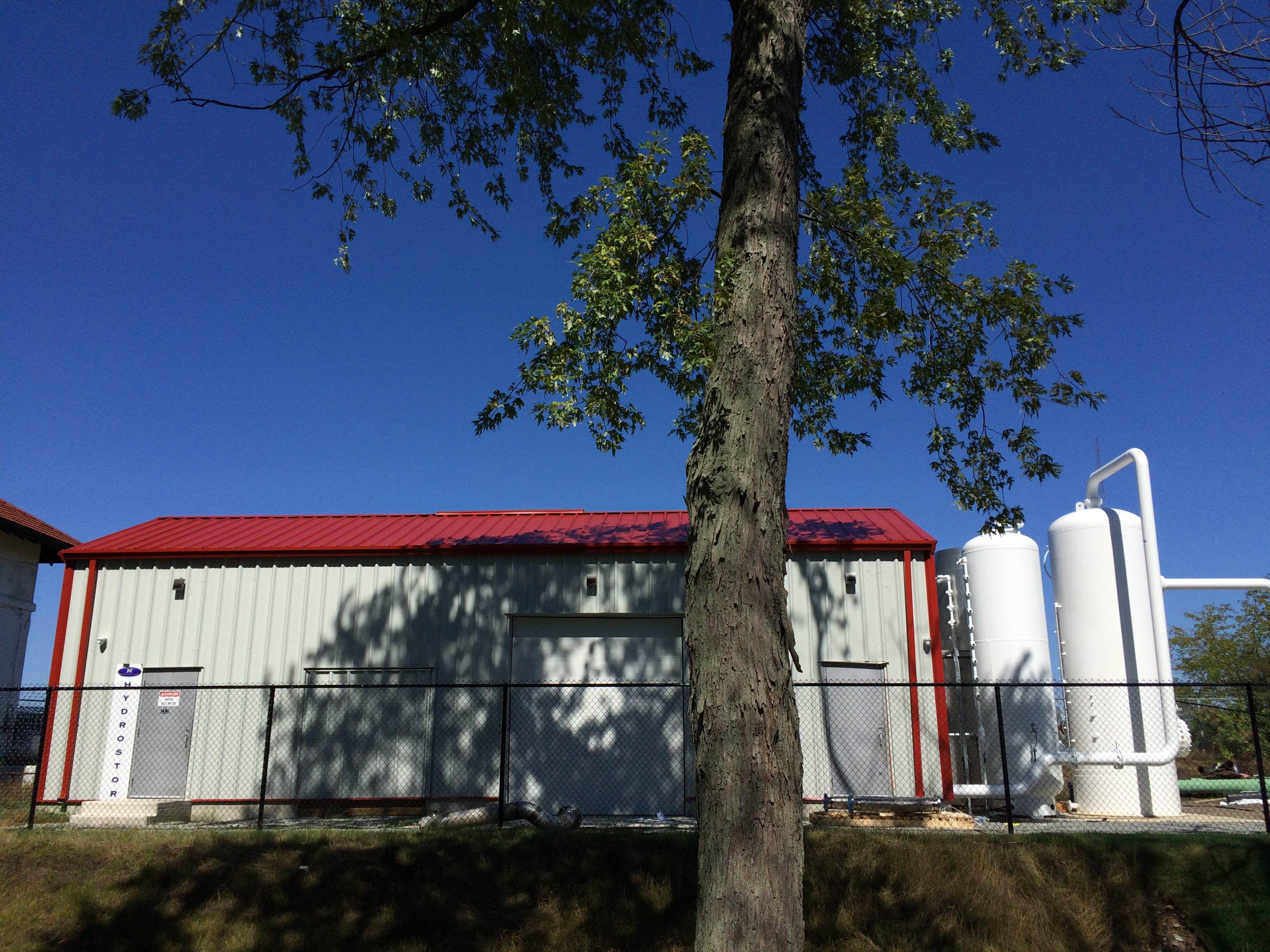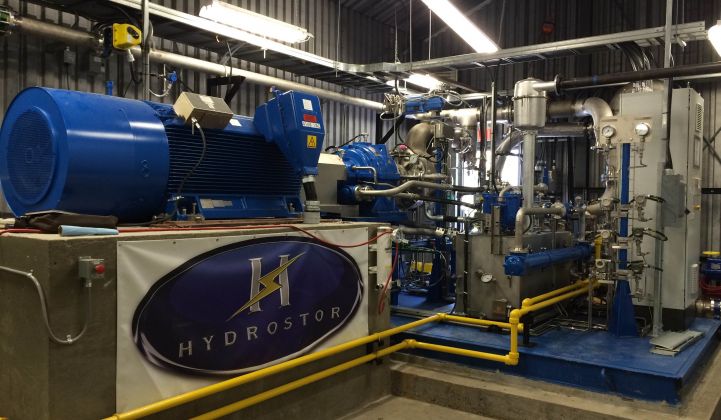Canadian firm Hydrostor revealed a new compressed-air storage solution it says can compete with both batteries and natural-gas plants to provide hundreds of megawatts of power.
The company adapted compressor technology well honed by the oil and gas industry to squeeze air down into custom-built tunnel shafts, using water to maintain constant pressure. It dubbed the resulting product Terra: a grid-scale, long-duration storage asset that lies mostly underground, with a visible footprint no bigger than a small industrial building.
By leveraging proven technologies and confronting the challenges posed by the physics of air compression, the Hydrostor team convinced Fortune 500 engineering firm AECOM to sign on as project developer partner -- and to backstop the systems with a cost and performance guarantee. Canoe Financial has committed to project financing. This puts Hydrostor in the rare position of rolling out a new storage technology with key bankability measures already in place.
That's crucial for the kinds of customers the firm is courting: primarily large, traditional utilities. Specifically, Hydrostor wants to use Terra to convert shuttered coal-powered generating facilities into peaking power plants that charge up on cheap grid electricity and discharge when needed, said President and CEO Curtis VanWalleghem. It can also perform transmission decongestion and renewables integration roles.
Lithium-ion batteries enjoy a near-stranglehold on the U.S. storage market. Any upstart device challenging their dominance has to show customers a very good reason to diverge from the conventional path. Plenty of storage companies have offered longer-duration batteries, but they struggle at beating lithium-ion on price.
The Terra solution is highly customizable and allows customers to pick the power-to-energy ratio. For systems of 200 megawatts or more, VanWalleghem said, Hydrostor can deliver 6 to 8 hours of duration on a turnkey installed basis of $150 per kilowatt-hour.
In its Q1 report on the U.S. storage industry, GTM Research calculated the median price for 4-hour utility-scale systems to be $550 per kilowatt-hour. That's expected to drop to $450 by 2019. It's not an exact comparison on energy capacity, but it's safe to say that the price point quoted for Terra (assuming it's accurate) is several years ahead of the rest of the advanced storage industry.
A new take on familiar ideas
The Terra concept responds to and re-envisions several things simultaneously: compressed air storage, grid-scale battery storage and the use of coal power plant sites. Here's the breakdown.
With all the hubbub around emerging storage technologies, it's rare to hear news of compressed-air energy storage (CAES). This technology, like pumped hydro storage, was proven years ago but has been hobbled by the vagaries of geology.
Traditional CAES seals air inside pressurized salt caverns. So to build one, you have to go find a cavern big enough for your needs and strong enough to withstand the pressure without leaking. Needless to say, it's not exactly a buyer's market.
More recent attempts to modernize the concept have focused on manufacturing sophisticated tanks that can hold the air. Lightsail raised $70 million to pursue, this and, as Eric Wesoff reported, didn't get much further than producing a sophisticated tank. SustainX raised $30 million for aboveground CAES, but ultimately had to abandon those plans. It attempted to merge with General Compression to improve below-ground CAES, but both have since wound down.
Hydrostor addressed the siting issue by creating caverns on demand. The company digs what look like mine shafts (more on that later) customized to the needs of a given project. The basic design goes down about 1,200 feet. A structure on the surface houses the equipment used to suck air in, pump it down to charge the system, and suck it back out to discharge. The team installs silencers on the vents to cut out noise pollution.
"We built one in downtown Toronto right next to a school, and it complies with all the noise ordinances," VanWalleghem said. Permitting involves different questions than a typical storage facility; it's more like getting mineral rights to dig on a piece of land, or excavating a city block for an underground garage.
Another challenge with CAES derives from physics: If you reduce the volume of a gas, the procedure produces heat. You have to deal with that heat, and then find a way to reintroduce heat when you discharge the air to spin a turbine.
Traditional CAES facilities burn natural gas to heat the cold air as it gets pumped back out of the system, but Hydrostor wanted to keep its operation clean and self-contained. The designers threw in several types of thermal storage to catch the heat given off by the initial air compression and save it for use when the system discharges. Omitting natural-gas burn also makes it possible to slip into urban settings -- the only emission from the process is air.
Lastly, the equipment operates best at a certain pressure level. Pumping more air into a confined space increases the pressure, so previous CAES designs used massive caverns to offset the additional pressure from charging.
Hydrostor cuts the cavity size and maintains constant pressure using water. Additional air displaces the water instead of more air, so the pressure doesn't vary and the machinery can run optimally.
The 1-megawatt Toronto test facility the company built uses an earlier marine design, which pumps the air into underwater balloons. Hydrostor is currently constructing a project for Ontario's Independent Electricity System Operator that will attach its compressor array to an existing salt cavern, and it's finalizing the first fully realized commercial application of the Terra concept.

(This is just the tip of the iceberg for Hydrostor. Photo Credit: Hydrostor)
A non-mythical energy plan for coal country
While Hydrostor can feasibly deploy its technology next to schools in city centers, it has another type of location in mind: the sites of retired coal plants.
When a coal-fired power plant shuts down, it leaves a large industrial site with a powerful transmission connection and ample supply of water. Those are all the ingredients Hydrostor needs to get a Terra installation up and running with minimal friction.
Those sites are useful for other energy assets too -- battery storage, solar or wind could make use of the transmission hookup. Hydrostor's pitch goes a little deeper by leveraging a different facet of the coal industry: the miners.
"We’ll be putting hundreds and hundreds of miners to work for many, many years," VanWalleghem said. "We’ve got trained miners who are great at what they do, oil and gas companies that have perfected compressors. We just add a couple of bells and whistles to it -- we don’t reinvent that other stuff."
Not all former coal power plants sit in regions with a coal miner workforce, but plenty of them do. Hydrostor will have to see whether this cultural and economic development pitch helps close deals. At the very least, it puts the company in the position of speaking the same language as the thermal power industries in a way that solar and wind do not.
President Donald Trump has argued that his efforts to cut environmental protections will bring back the coal industry. He has not supplied evidence that this is the case. A large-scale construction project utilizing the coal miner workforce, on the other hand, could provide real economic opportunities in a growing clean energy industry.
Going to battle with batteries
Given the near-total market dominance of lithium-ion, and new contender faces a high bar. VanWalleghem acknowledges that there are certain areas where his technology won't beat the incumbent.
Modern batteries can respond to commands in a matter of milliseconds; the Terra needs a few minutes to get from cold start to full power.
We saw with the Aliso Canyon procurements that grid-scale lithium-ion systems can be deployed on the grid in just six months. Given the physical construction involved in Terra, it takes more like two to three years from contract to service.
Terra facilities offer 60 percent round-trip efficiency on a single day charge/discharge cycle, which is lower than flow batteries, and considerably lower than lithium-ion.
But on the other hand, the company claims the efficiency does not degrade over time the way batteries do. There is no flammable chemical concern of the sort that has stymied the advance of lithium systems into dense cities like New York.
The latter has a fixed ratio of power to energy; expanding duration means adding more lithium-ion cells. Terra allows the customer to choose exactly what performance specifications are desired: the compressors govern the power intake capacity and the volume of the underground cavity corresponds to energy capacity.
The scale here can get pretty massive. If Hydrostor builds the 200-megawatt system VanWalleghem quoted, that would exceed any advanced battery system that exists. AES has a contract with Southern California Edison to deliver a 100-megawatt/400-megawatt-hour system in Long Beach by 2021 that's slated to be the largest battery of its kind. Hydrostor says it can beat that.
When you're dealing with such massive amounts of electricity, Terra can arguably afford to lose 40 percent of the electrons that go in, because it can still produce more than any other battery.
The right kind of friends
Hydrostor has an alluring and detailed pitch, but clever engineering doesn't guarantee success in the world of energy storage. The company has increased its odds, though, by laying a strong business foundation before launching the new product.
The group has raised about $10 million in equity and garnered another $10 million in government grants, and has begun earning revenue on the Ontario project, which contracted for close to $10 million as well.
That's a promising start, but not enough of a balance sheet to guarantee a large and expensive system for a utility client that needs assurances it will work. That's where AECOM comes in.
That firm, which operates in 150 countries and drew $17.4 billion in revenue last year, partnered with Hydrostor after an extensive review of operational data from the pilot project and market analysis. AECOM serves as the project developer, and guarantees the projects for 30 years or more, several times the life expectancy of a lithium-ion battery.
Even before the official marketing for Terra has begun, AECOM has been hearing positive feedback from multiple stakeholders, wrote Travis Starns, principal engineering manager there, in an email Wednesday.
"We believe once this technology is known within the energy storage landscape and stakeholders are able to add the Hydrostor Terra technology into the evaluation process, the value proposition for this technology will become clear," he said.
That connection is a big deal for a new storage technology, said Ravi Manghani, energy storage director at GTM Research.
"Getting a partner like AECOM is going to make their jobs much easier," he said. "It’s easier to get on meeting calendars with big utilities and big financial institutions."
The backing from AECOM makes Terra projects financially bankable. The strategy of using off-the-shelf mechanical equipment likewise reduces the risk associated with deploying new technology. That said, however, the fact remains that the configuration of the equipment is novel.
A key challenge for Hydrostor will be to convince customers to try out a product that relies on complex mechanical systems and a great deal more physical labor than a straightforward container of batteries.
"It's not like electrochemical batteries don't have their own issues, but they do have fewer moving pieces and hence fewer points of failure," Manghani said. "Compressed air, with so many moving parts and dealing with high-pressure environments, adds on a number of potential points of failure."
For companies used to dealing with all the moving pieces of a coal or gas plant, the Terra won't feel all that foreign. If even a few of them sign on, Hydrostor could have its hands full with a few hundred megawatts to install.



